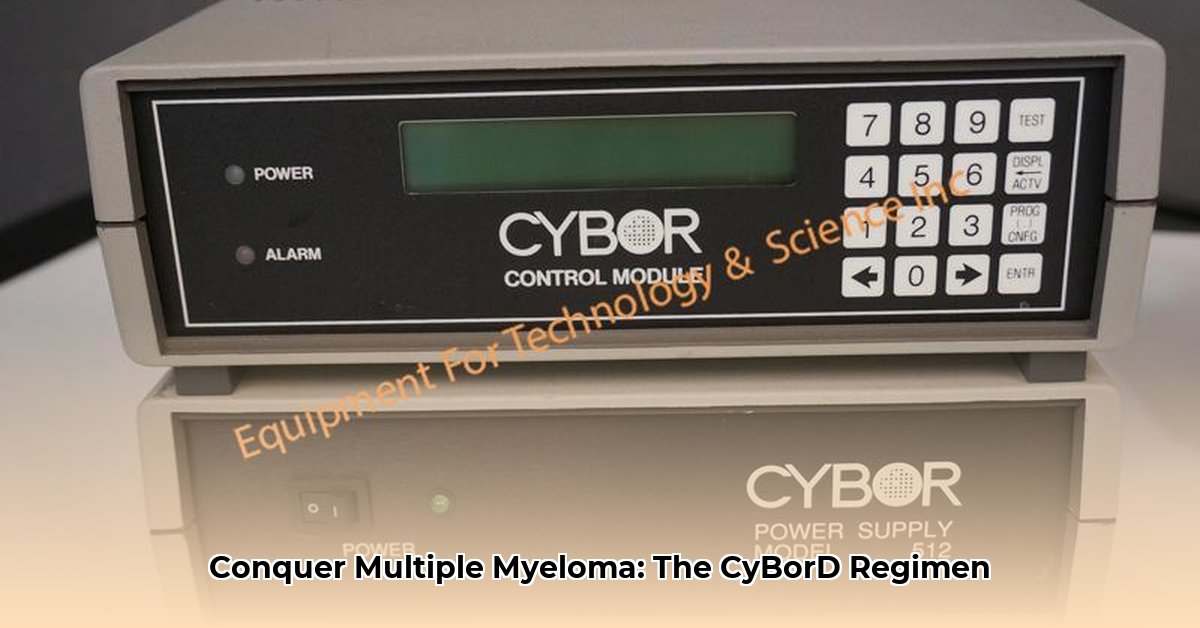
This guide provides a detailed yet accessible overview of the CyBorD (Cyclophosphamide, Bortezomib, Dexamethasone) regimen for multiple myeloma (MM). We will explore its mechanism of action, potential side effects, management strategies, and long-term considerations. This information is intended for educational purposes and should not replace consultation with your healthcare provider. Always discuss your individual treatment plan with your oncologist.
Understanding the CyBorD Regimen
Multiple myeloma is a complex cancer requiring a multifaceted treatment approach. CyBorD, a combination chemotherapy regimen, addresses this complexity by combining three distinct drugs with complementary mechanisms of action. The treatment is administered in cycles, typically lasting 28 days. The exact number of cycles required varies depending on individual patient responses and is determined in consultation with the treating physician.
The Three-Pronged Approach: How CyBorD Works
CyBorD leverages the synergistic effects of three medications:
Cyclophosphamide: A traditional alkylating agent chemotherapy drug that directly damages DNA in myeloma cells, preventing their replication and growth.
Bortezomib: A proteasome inhibitor. Proteasomes are cellular structures responsible for degrading proteins. Bortezomib's inhibition of these structures leads to the accumulation of toxic proteins within myeloma cells, triggering programmed cell death (apoptosis).
Dexamethasone: A corticosteroid with both anti-inflammatory and direct anti-cancer properties. It aids in reducing myeloma-related inflammation and enhances the efficacy of the other two drugs. This combination creates a potent three-pronged attack on myeloma cells.
Is CyBorD right for every multiple myeloma patient? Not necessarily; suitability depends on factors like disease stage, overall health, and potential drug interactions. Your oncologist will conduct a thorough evaluation to determine the most appropriate treatment plan.
Potential Side Effects and Management Strategies
While CyBorD offers significant therapeutic benefits, it's crucial to be aware of its potential side effects. These can vary in severity and frequency among patients. Early identification and proactive management are essential for optimal treatment outcomes.
Common Side Effects of CyBorD
Myelosuppression: This refers to a decrease in blood cell production, potentially leading to anemia (low red blood cells), thrombocytopenia (low platelets), and neutropenia (low white blood cells). This can increase the risk of infection, bleeding, and fatigue. Regular blood tests are essential to monitor blood counts.
Peripheral Neuropathy: Nerve damage, often manifested as tingling, numbness, or pain in the hands and feet, is a common side effect. Pain management strategies and dose adjustments may be implemented.
Hyperglycemia: Increased blood sugar levels may occur, particularly in patients with pre-existing diabetes. Careful blood glucose monitoring and adjustments to diabetes medications or diet are crucial.
Thromboembolic Events: There's a slightly increased risk of blood clots (thrombosis) and pulmonary embolism. Your doctor will monitor for any signs and may prescribe blood thinners if necessary.
Gastrointestinal Issues: Nausea, vomiting, and diarrhea can occur. Anti-nausea and anti-diarrheal medications can help manage these symptoms.
Proactive Management: A Step-by-Step Approach
Regular Monitoring: Adhere meticulously to scheduled appointments for blood tests and checkups. This allows for early detection of side effects.
Open Communication: Report any new or worsening symptoms immediately to your healthcare team. Prompt reporting is crucial for timely intervention.
Lifestyle Modifications: Maintain a healthy diet, engage in regular, moderate exercise, and prioritize adequate rest. This supports overall health and resilience.
Medication Adherence: Strictly follow your prescribed medication regimen. Do not deviate from the dosage or timing without consulting your doctor.
Supportive Care: This may include blood transfusions for anemia, medications for pain management or blood sugar regulation, and prophylactic antibiotics to prevent infections.
Long-Term Outlook and Alternative Treatment Options
The long-term effects of CyBorD are subject to ongoing research, and treatment plans are often tailored to an individual's response. After completing the initial CyBorD regimen, your oncologist might recommend maintenance therapies or consider other treatment options depending on your individual response and disease progression.
Conclusion: Collaboration and Empowerment
Navigating myeloma treatment requires a collaborative approach. Open communication with your healthcare team, coupled with proactive side effect management, is key to optimizing treatment efficacy and quality of life. Remember that you are an active participant in your treatment journey; your insights and questions are vital for the best possible outcomes. This guide empowers you with knowledge, but always remember to discuss your treatment plan with your healthcare provider.